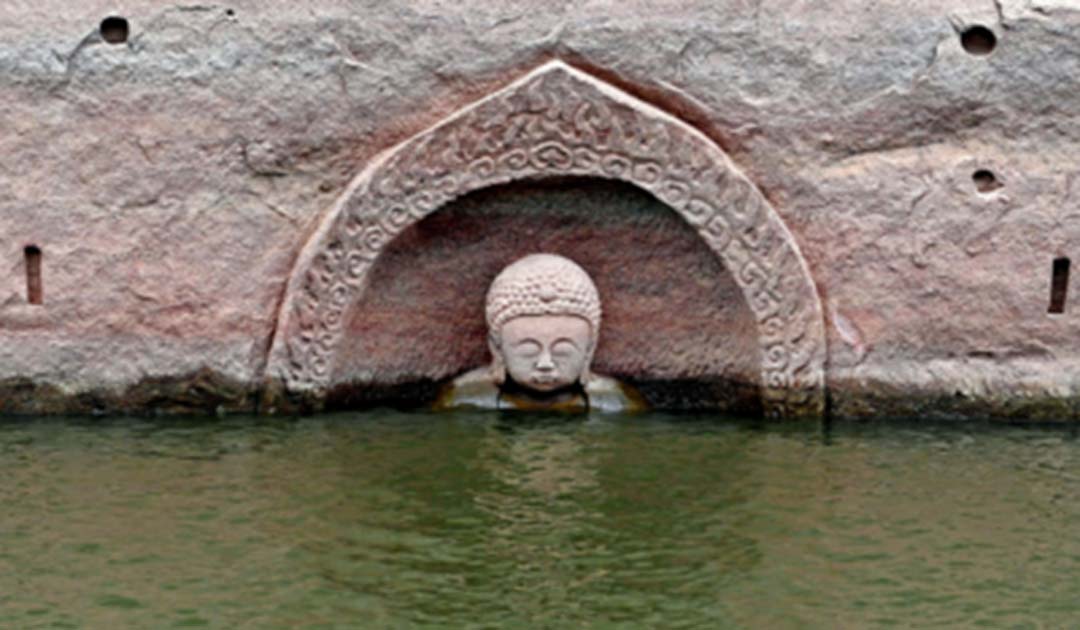600-Year-Old Buddha Statue Temporarily Emerges from the Waters, Reminding Locals of a Forgotten Past
The head of a Buddha statue estimated to be 600 years old recently emerged from a Chinese reservoir in Nancheng County, when water levels receded during renovation of a hydropower gate. A temple at the base of the 12.5-foot-tall (3.8-meter) Buddha statue points to the importance of the site to villagers during the Ming Dynasty (1368 to 1644 AD), or even the earlier Yuan Dynasty.
Xinhua reports that the water level in the reservoir in Jiangxi province fell about 10 meters (33 feet) to reveal the head of the statue carved into a cliff. Divers went in the water to investigate and found the foundation of a temple, which measures about 165 square meters (541 square feet).
It is expected that the Buddha will be submerged once again when the water levels rise.
- The Leshan Giant Buddha: Largest Stone Buddha in the World
- Could There be a Third Bamiyan Buddha, Hidden for Centuries?

Underwater archeologists investigating the site. (CNN)
A villager was the first person to notice the head of the statue, the official Chinese news agency Xinhua reports. The age of the statue was estimated based on its design.
The Buddha statue was built at the confluence of two rivers, which was a dangerous place to navigate because of rapid water flow. It was hoped that Buddha would keep boats from capsizing, Guan Zhiyong, head of Hongmen Township said. “According to folk tale, the ancient people built the statue to pray for safety.”
Some of the people who were required to move when the reservoir flooded their lands in 1958 returned to visit the site and see the statue. Huang Keping, 82, who had lived near the statue, was one such visitor. “I went to the temple in 1952 and saw the Buddha statue for the first time. I remember the statue was gilded at that time," Huang said.
Despite the loss of the gilt, the statue was in good shape because being submerged prevented vandalism and erosion. During the Cultural Revolution of 1966 to 1976, some Chinese people destroyed some historic sites.
The ruins of an ancient village, Xiaoshi Township, were also submerged when the Hongmen Reservoir was created in 1958. The old township was a hub for travel between Jiangxi and Fujian provinces, Xinhua reports. It was also an important trade center.
"The ruins of Xiaoshi town were not exposed by the lowered water levels, but the underwater team also explored the town," Jin Huilin, curator of the museum of Nancheng County, told Xinhua.
- Cosmic Buddha: High Tech Scan of Ancient Chinese Statue Reveals Stunning Illustrations Depicting Buddhist Teachings
- Over 1,000 ancient Buddha statues uncovered in China
This Buddha statue is not the only one in China and the Far East. One of the most impressive examples is in Sichuan Province.
As Bryan Hill reported for Ancient Origins in 2015, the Leshan giant Buddha statue is carved into the side of Mt. Lingyun. The colossal statue is over 1,300 years old and is considered to be the largest stone Buddha in the world, and by far the tallest pre-modern statue. The site attracts millions of people every year, including Buddhist pilgrims, making it something of a sacred destination and an ancient wonder of the world.

1021 twists make up the hair of the Leshan Buddha. (Chi King / CC BY 2.0)
The statue is ten stories high, and if the statue stood upright, it would be almost eye to eye with the Statue of Liberty. The Buddha is enormous. Measuring 71 meters tall (233 feet), the statue has a symmetrical posture, creating a gracefully relaxed image. Its head is 15 meters (50 feet) high, its shoulders 28 meters (92 feet) wide, and its smallest toenail can accommodate a seated person. Each eyebrow alone is 5.5 meters (18 feet) while its nose is 6 meters (20 feet) long. A large pair of ears, measuring seven meters (23 feet), is capable of holding two people inside.
- Mini Golden Coffin Found in Crypt May Hold Skull Bone of Buddha
- The Laughing Buddha: The Eccentric Monk, God of Plenty and Patron of Bartenders
Like the recently exposed statue in Nancheng County, legends say that the Leshan Giant Buddha statue was also built to calm turbulent waters that capsized countless boats. Its creation was pushed forward by a Tang Dynasty monk named Hai Tong.

The Leshan giant Buddha. (CC BY SA 3.0)
Other interesting Ming era Buddha statues have also been rediscovered in recent years. In 2014, April Holloway reported in an Ancient Origins article on the find of more than 1,000 Ming Dynasty Buddha statues in three caves in Shaanxi Province.
The Ming dynasty was the ruling dynasty of China for 276 years following the collapse of the Mongol-led Yuan dynasty. Ming was the last dynasty in China ruled by ethnic Han Chinese. The creation of stone Buddha statues reached its peak during the period from the Northern and Southern Dynasties (420-589) to the Tang Dynasty (618-907), so it is rare to find stone Buddha statues from the Ming Dynasty.

A porcelain statue of Kuan Yin from the Ming Dynasty. (CC BY SA 3.0)
Top Image: The head of the 12.5-foot-tall statue depicting Buddha was revealed when waters of a reservoir created in 1958 recently sank low enough. Source: Xinhua/Wan Xiang
By Mark Miller



















